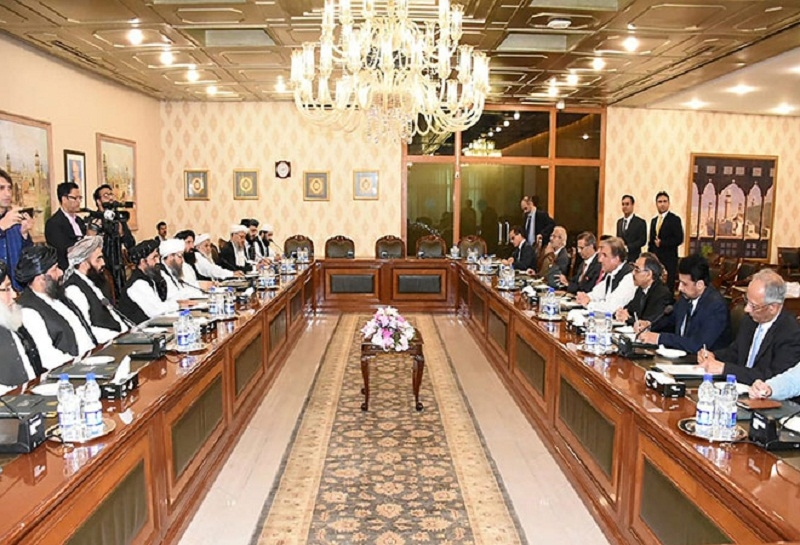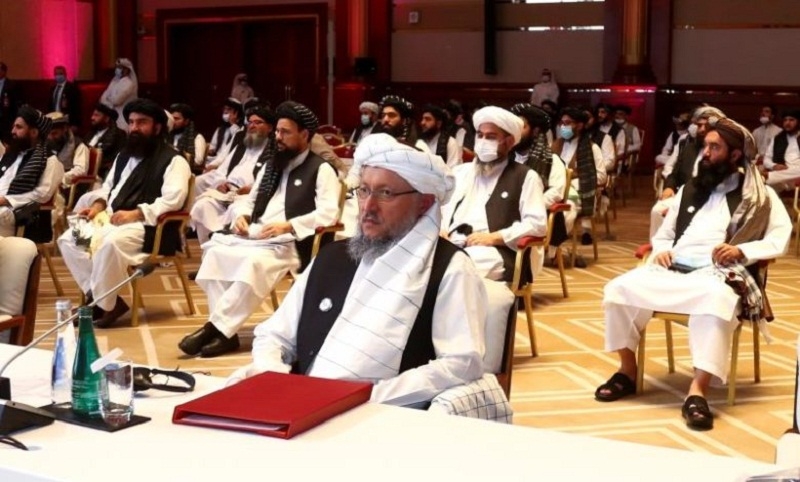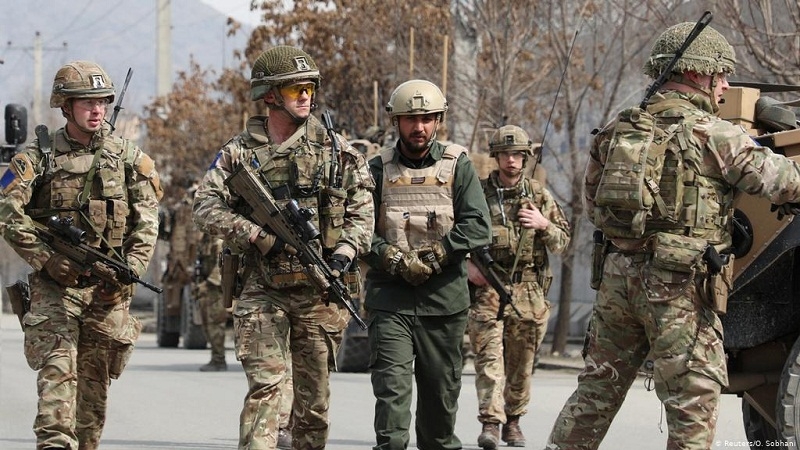Peace Talks Impasse & rise of Afghan Taliban & Allied Groups

Peace talk’s impasse persists. If the consortium of global and regional leaders – Joe Biden, Putin, Xi Jinping, Hassan Rouhani, Recep Tayyip Erdoğan, Imran Khan among others – expect to unite sinking their strategic interests and untie the Gordian knot of “Graveyard of Empires” to usher enduring peace in Afghanistan, they are only over estimating their powers. Such is the chemistry of the environment – violent and volatile societal content and context. The rise of the Afghan Taliban and allied groups is real.
Many peace initiatives in the past include: The Doha Debacle 2011 -2013; Pugwash initiative May 2015; Urumqi Talks May 2015; Oslo Talks, June 2015; 2+2+1 or Murree Peace Process July 2015; Heart of Asia’ Ministerial Conference, December 2015; Quadrilateral Coordination Group (QCG) January 2016; Afghanistan–Gulbuddin deal (2016); Moscow six party talks April 2017; Kabul peace process June 2017; Conference of 20 countries in Tashkent, Uzbekistan, Taliban March 27, 2018; the U.S. and the Taliban in Qatar in October 2018; Russia hosted a separate peace talk in November 2018, February and May 2019; Qatar talks in February 2019 and August 2019; Taliban delegation to Russia, China, Pakistan, Iran to discuss prospects for a withdrawal of U.S. resumption of Peace negotiations in December 2019; U.S.–Taliban deal (2020); and Intra-Afghan negotiations in Doha September2020; and continuing.
What will be the fate of the Afghan National Army (ANA) and the Police having waged wars against the Afghan Taliban Islamist radical forces? Will they merge with the Afghan Taliban forces or splinter, melt and regroup under ethnic warlords to live to fight yet another day and another war!
“Graveyard of Empires” is the historic legacy of interventions in Afghanistan - the Soviet Union in 1980s and the U.S. today. Russia, “Once bitten, Twice Shy”, may not enter directly into the fray. Islam is the fastest growing religion with 25 million out of 146 million as of 2020. Russia too faces Chechen Islamists threat. Also, it has sizable Muslim populations in the border regions. At the same time, Russia too can ill afford to stand as mute spectator to Islamist radicals attempting to overthrow secular Central Asian Region Muslim nations. Similarly, China may be concerned about Ughiyur Islamists returning from Afghanistan emboldened. Chinese too would avoid getting trapped in the quagmire. Even Shiite Iran has a major stake in the peace and stability in Afghanistan. Not to be left out of consideration is also Turkey.
The root cause for the historic notoriety as “Graveyard of Empires” is the extraordinary complex ethnic divides and inherited intra and inters bloody, fractious and internecine feuds. 300-400 Pashtun clans and warlords astride the Durand Line, Taziks, Hazaras, Uzbeks, Turkmen, Nuristani and Baloch represent the social divide. With the support extended by Pakistan, Iran and Russia to a mix of Afghan central government forces, local militias, and insurgent groups, the bubble of unity, if forged, can blow up any time. A bloody Civil War is a distinct prospect.
The intra-Afghan talks are deadlocked. First, the key Afghan actors - Ashraf Ghani, Hamid Karzai, Abdullah Abdullah, Abdul Rashid Dostam and others - need to resolve their differences on power sharing arrangements. After all, the Tajiks, Uzbeks, and Hazari groups do not want to be governed by the Pashtun Taliban. Even urban Afghans don’t want the medieval Islamic Emirate.
Next, “war is employment and peace is unemployment” for Islamist terrorists. Warlords will be deprived of royalties from the U.S. Narcotics will be their main source of income. So, vested interests can sponsor Islamist terrorist employment in all countries.
During the early discussions, the Taliban proposed that disputes be decided exclusively by Sunni jurisprudence. Government delegates insisted on Shiite population representation. The Taliban—whose members had massacred Shiite civilians before 2001—stormed out of the room. Even the Afghan Taliban hardliners may rescind any power sharing agreement with Afghan parties sooner than later.
A brief review of the state of the Afghan Taliban, the al-Qaida, the Haqqani Network, the Tehreek-e-Taliban Pakistan (TTP), the Al-Qaeda in Indian Continent (AQIS), the East Turkistan Islamic Movement (ETIM), the Islamic Movement of Uzbekistan (IMU), Lashkar-e-Taiba and Jaish-e-Mohammad provides a peep into their capabilities and intent not only in Afghanistan, but elsewhere globally in pursuit of Jihad.
The Afghan Taliban, Islamic Emirate of Afghanistan, is on the cusp of victory over the U.S. and its allies. Surely, one should not expect the Afghan Taliban to squander away the opportunity to capture power in Kabul. The Afghan Taliban also has “good or bad” and “hard-line and moderate” leaders. The hard-line faction opts for complete takeover of Afghanistan. Moderate factions may agree to power sharing concessions under international and regional pressures. Pakistan and China would like to have their protégés in power. Other regional and international actors would like to have influence in Kabul.
At present, the Afghan Taliban with Mullah Akhundzada is remaining in charge with support of three loyal deputies: Mullah Abdul Ghani Baradar, Siraj Haqqani, and Mullah Yaqoob. They have successfully forged consensus on key issues such as the timing of the cease-fire, terms of the withdrawal of U.S. forces and sequencing of the peace process. Also, the rank-and-file is united. The group has regulated membership of the top-decision making body, the Rahbari Shura. Mullah Akhundzada appointed Mullah Baradar, one of the cofounders of the Taliban movement, to lead the peace talks with the U.S. government in 2018. The appointment of the chief justice of the Taliban’s judiciary, Maulvi Abdul Hakim, to lead the negotiations with the Afghan government is yet another key decision.
In the Peace Deal with the U.S. the Afghan Taliban pledged to break from al-Qaeda and ban the use of Afghan territory for terrorism against other countries. Its leadership has no real intent to engage in transnational terrorism. Some Afghan Taliban groups are wary of a relationship with al-Qaeda. But Important Afghan Taliban leaders, such as deputy leader Siraj Haqqani and senior military chief Ibrahim Sadr, remain sympathetic to al-Qaeda for the global jihad project. Al-Qaeda remains popular among the rank-and-file of the Taliban. For now, the balance of internal elite opinion seems to be in favor of the group. So, it is unlikely to crack down on al-Qaeda, but regulate the behavior of al-Qaeda groups.
Most important, the enduring relationship between the Afghan Taliban and the al-Qaida is based on firm ideological and political convergence, that is, joint stewardship of global jihad — drawing on the Hanafi school of Sunni Islamic theology, the centrality of jihad in its interpretation of Islamic theology, and its role and status as guardians of Islam in Afghan society. The relationship provides opportunity to move leadership and personnel from Syria, Iran, Pakistan, and Jordan to Afghanistan.

Also, Al-Qaeda retains alliances with other important armed groups, such as the Tehreek-eTaliban Pakistan (TTP), the Al-Qaeda in South Asia (AQIS), and the East Turkistan Islamic Movement (ETIM). In addition, after losing its alliance with the Islamic Movement of Uzbekistan (IMU), al-Qaeda has improved its ties with a number of other Central Asian groups, such as Khatiba Imam al Bukhari, Katibat al Tawhid wal Jihad, and Islamic Jihad Group, which remain based in northern Afghanistan.
Yet another significant feature is the strength and intent of Jihadi foreign fighters. They believe that they are the heirs to ancient tradition of “Jihad”, fighting for over the last 30 years in Afghanistan to include: Arabs, Pakistanis (Both Pashtun and Punjabi origins), Uzbekistanis (not Afghan Uzbeks), Turks, Uighurs from China, Bangladeshis, Indian Muslims and few Westerners and North Africans. They range from genuine fanatics brainwashed, to mercenaries to earn money, adventurers, escapist-dreamers, and many others. Several of them readily admitted to having fought alongside ‘‘Araban.’’ These ‘‘Talib-ulims,’’ followed a long history of borderless jihadi volunteerism traced to the ghazis (holy warriors) and murabitun (wandering fighters) of Medieval Muslim states of North Africa and Middle East.
According to estimates, the total number of al-Qaeda fighters is between 45,000 and 60,000 with Pakistanis, but not Arabs and Uzbeks, as the largest component of foreign fighters in Afghanistan. As per a July 2020 estimate, there are more than 6,000 TTP fighters and 2,000-strong Haqqani Network of fighters in Afghanistan. And, foreign Islamist fighters have a less stable relationship with the Pakistani government. According to Jane’s World Armies, on the eve of 9/11 there were as many as 5,000 Uzbek and Arab fighters in the ranks of the Taliban.
Uzbek fighters from the IMU carried out summer raids into Kyrgyzstan, Tajikistan and Uzbekistan with the aim of overthrowing the region’s secular governments. Under al Qaeda influence they, like the Taliban, adopted a more global worldview and began to call for jihad against Israel and the U.S., not just the overthrow of President Islam Karimov’s regime in Uzbekistan.
There is also a concerted effort is to poach control of or induce defections from Pakistan-backed jihadi groups, like Lashkar-e-Taiba and Jaish-e-Mohammad. Usama Mahmood, who appears to have been in-charge of al Qaeda’s Kashmir strategy for the last few years, has emphasized the importance of al-Qaeda’s Kashmir affiliate Ansar Ghazwatul Hind to the group’s regional strategy. A small number of Uighurs (an ethnically related Turkic Muslim people from Xinjiang Province China) is based in Afghanistan under the Taliban.
Yet another significant actor is the Islamic State in Afghanistan – Khorasan (IS-K), which is in steady decline. At one stage in the past, IS-K had challenged the Taliban leadership maintaining presence in 25 out of Afghanistan’s 34 provinces, according to the United Nations. IS-K receives funding from the Islamic States Central Command and is in contact with leadership in Iraq and Syria. But its operations are controlled by local commanders. In early 2016, the IS-K leadership fractured into Pakistani and Afghan groups. In the past, AQIS and the TTP experienced major challenges to their cohesion through extensive fratricide and defections to the IS-K chapter. There was also friction in its relationship with the Haqqani Network. This conflict was facilitated by Pakistani intelligence service ISI. Some surviving cells are engaging in large attacks. There are reports that a variety of actors, such as the Afghan Taliban, the Afghan government, and regional countries like Pakistan and India, are instrumental for the IS-K surviving operatives to score and settle issues. Its residual presence in major Afghan cities continues to pose a security threat to civilians.
Few analysts worry about a potential resurgence of the Islamic State. Another camp speculates that the IS-K has positioned itself to absorb fragmenting factions of the Taliban in the event of a peace deal. The IS-K’s new leader Abu Muhajir is leveraging his Arab ethnicity to settle disputes within the group and mobilize fighters and resources from ISIS’s central organization in Iraq and Syria. Another view, expounded by members of the Afghan security forces, suggests that the Afghan Taliban, and specifically the Haqqani Network, and regional countries may support the IS-K by carrying out plausibly violence to derail the peace process. It is premature to write off the Islamic State.
Not to be left out of consideration is the role of AQIS. Its charter emphasizes targeting of U.S. interests and citizens in Pakistan or India as a key objective. Significantly, the U.N.’s July 2020 report warns that AQIS is planning operations in the region to avenge the 2019 U.S. targeting of its chief, Asim Umar. AQIS also works closely with the TTP in Afghanistan. If the TTP ramps up targeting of Pakistani forces, al-Qaeda may support its campaign from Afghanistan. In addition, al-Qaeda in general and AQIS in particular devotes substantial energy to highlighting excesses in Kashmir.
Al Qaeda may also consider using Afghanistan for its Kashmir plans in tandem with Pakistan-aligned jihadist groups, like Jaish-e-Mohammad and Lashkar-e-Taiba. Al-Qaeda’s affiliates and allies in Afghanistan also show interest in targeting China’s Belt and Road Initiative projects in Pakistan and Central Asian states.

In sum, the rapid expansion of Al Qaeda and its alliance partner’s capabilities under the aegis of the Afghan Taliban portends an increasing likelihood of directed or inspired attacks against U.S. and allied homeland. Its intent and likely expansion of transnational terrorism capabilities aligns with themes in AQIS propaganda. Beyond a strategy of conducting attacks in the West, al-Qaeda might use its growing capability for regional operations against or inside various countries: Pakistan, India, Central Asian nations and even China.
Viewed in the extraordinary complexity, Afghanistan is at crossroads. The Taliban is engaged in peace talks. But, the path to enduring peace is vexatious. And, terrorism challenge remains multifaceted and likely to persist. However, it is realistic to assume that a number of groups with varied local, regional, and transnational aims will find ways to strike. In turn, their presence will generate regular risks for Afghan civilians, the region surrounding Afghanistan, and Western countries.
All international and regional actors want peace and stability in Afghanistan. Yet, there is lack of convergence on the ways of resolving the crisis. Unless all groups alike first sink their intra differences, and also other international and regional actors – U.S. Russia, China, Pakistan, Iran, Central Asian Nations, Turkey, India etc - reach consensus on new frameworks of management of peace keeping, peace forging and peace consolidation under the UN framework, peace and stability in Afghanistan is a forlorn hope.
